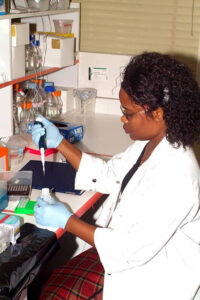
With an increasing number of states slowing the pace of reporting on COVID-19 cases, journalists should consider keeping an eye on wastewater testing efforts as they have the potential to signal COVID-19 case flare-ups weeks before they emerge more broadly in communities.
Earlier this year, the CDC unveiled a nationwide data dashboard that reports on the SARS-CoV-2 virus in sewage. Though sewage data are not collected in all 50 states — 18 have no wastewater analysis sites — enough data are being collected for the CDC to spot a coming surge in COVID-19 cases.
“If you live somewhere that this [wastewater] surveillance is happening, I highly recommend keeping an eye on those trends to watch for early warnings of future surges,” data analyst Betsy Ladyzhets wrote in her Feb. 27 COVID-19 Data Dispatch newsletter.
Wastewater and COVID-19
Wastewater is water that returns to the public utility system after being used for flushing a toilet, bathing, washing dishes, etc. In wastewater surveillance, public health officials collect sewer system samples — underneath specific buildings or water treatment plants — to test for infectious pathogens like SARS-CoV-2.
Sewage sampling has been a key tool in COVID-19 surveillance because it can pick up the coronavirus regardless of whether people have health insurance or access to COVID-19 testing. People begin shedding SARS-CoV-2 in their feces early in their infection before they experience COVID-19 symptoms. Sewage detection can signal up to two weeks in advance that there is a surge in cases brewing and prepare hospitals for patients hitting emergency rooms.
For example, the coronavirus identified in Boston’s wastewater increased before Boston’s Omicron case numbers did and then went down before case numbers did. Missouri’s wastewater surveillance system — which includes genetic sequencing for variants — identified Delta cases last summer weeks before laboratory testing, according to Ladyhetzs’ COVID-19 Data Dispatch article.
Sewage sampling “is extremely efficient — a ‘sewershed’ may involve dozens of people living within a dorm or working in a building, to hundreds, thousands or even millions of people,” Este Geraghty, M.D., M.S., M.P.H., G.I.S.P., a physician and chief medical officer of the private data analysis company Esri, told Wired magazine. “It’s passive; nobody has to do anything except for the water utilities and the public health authorities. And it’s not intrusive.”
Wastewater surveillance, a crucial aspect of epidemiology, has been around since 1854 when physician John Snow, M.D., traced a cholera outbreak in London to contaminated well water. In the 20th century (in 1954), epidemiologists in South Africa, began using it to detect parasites contaminating local drinking water. Currently, around 58 countries use wastewater surveillance as part of public health efforts, according to the CDC.
Amy Kirby, Ph.D., M.P.H., the CDC’s lead for the National Wastewater Surveillance System, also said in a media briefing that the agency is supporting 37 states, four cities, and two territories to help them develop wastewater surveillance systems and more than 400 testing sites around the country have already begun their wastewater surveillance efforts.
“Visitors to the [CDC] site will be able to see changes in virus levels in wastewater over the previous 15 days for each participating community, as well as the percentage of tests from the past 15 days that are positive,” Kirby said.
Wastewater surveillance may also be a key in signaling if the public health system is facing antibiotic resistance in a particular community and could pick up the next pathogen of pandemic potential. In New York City, for example, researchers have been finding strange versions of SARS-CoV-2 with mutations that haven’t been spotted in humans. Scientists don’t know if it means a new variant of concern will emerge or if it is a variant carried in animals like rats and is of no concern to humans.
“I think it’s really important that we find the source, and we have not been able to pin that down,” John Dennehy, Ph.D., a virologist at Queens College and co-author of a Feb. 2022 paper published in Nature about the cryptic variant found in wastewater, told the New York Times.
So, find out if your public health department is conducting wastewater surveillance for COVID-19 and other pathogens.
Experts to call
- Monica Trujillo, Ph.D., is a microbiologist and associate professor at Queensborough Community College; MTrujillo@qcc.cuny.edu.
- Marc Johnson, Ph.D., is a molecular virologist and professor at the University of Missouri School of Medicine; marcjohnson@missouri.edu.
- Davida Smyth, Ph.D., is a microbiologist at Texas A&M University; dsmyth@tamusa.edu.
- Rose Kantor, Ph.D., is a microbiologist at the University of California, Berkeley; rkantor@berkeley.edu.
- Issmat Kassem is a microbiologist and assistant professor at the University of Georgia’s Center for Food Safety; iik33253@uga.edu.
- Samuel Scarpino, Ph.D., is managing director of Pathogen Surveillance at the Rockefeller Foundation and a member of its Pandemic Prevention Institute. Scarpino is also an affiliate assistant professor at Northeastern University; s.scarpino@northeastern.edu.




